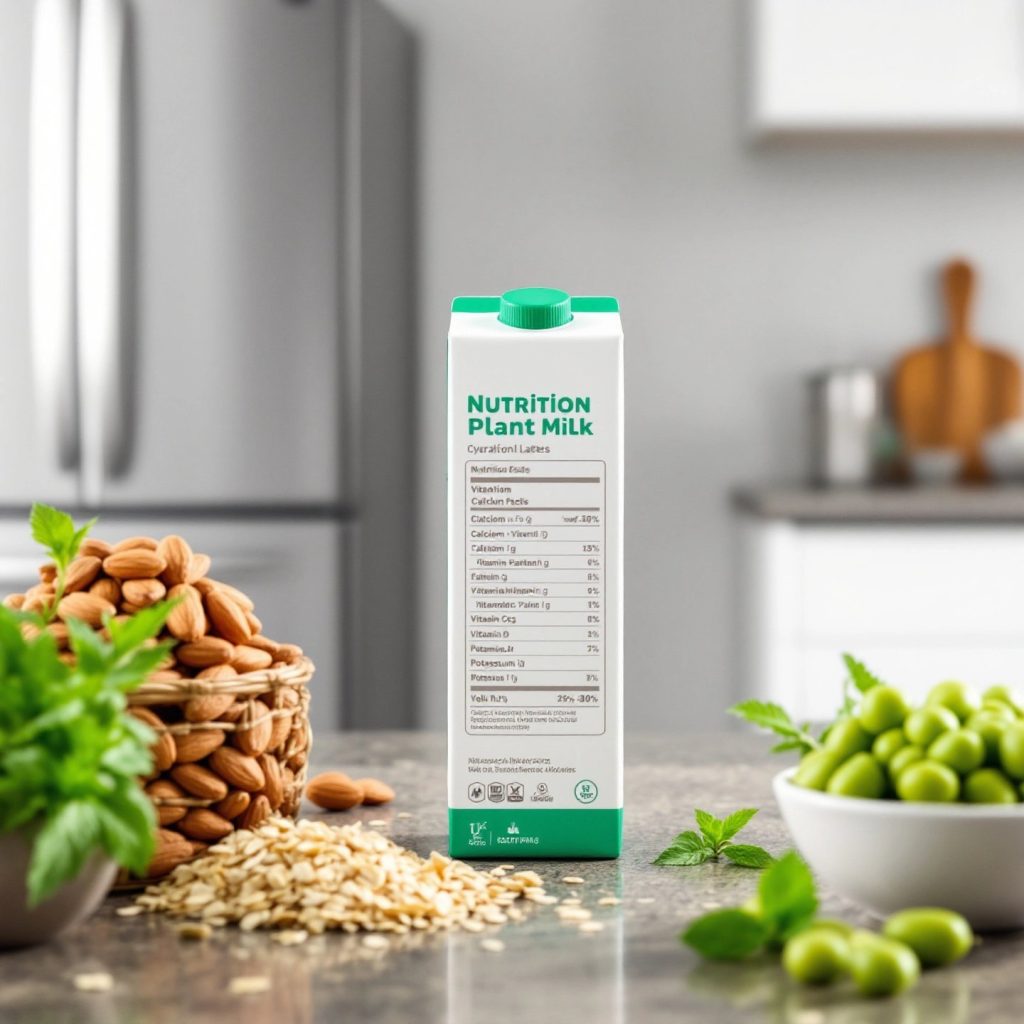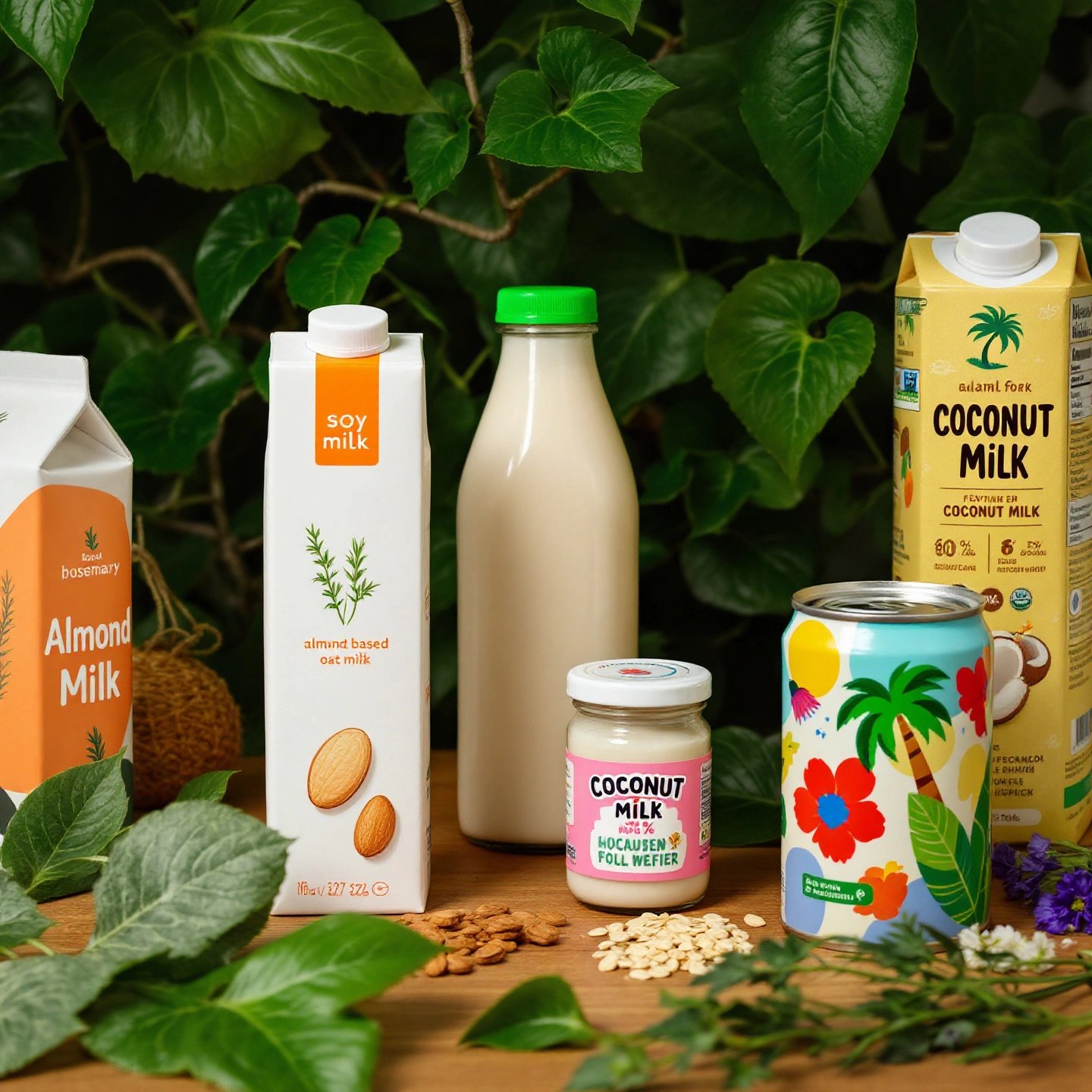Introduction to Plant Milk: A Growing Trend
In recent years, plant milk has surged in popularity as a leading dairy alternative, captivating the interest of consumers worldwide. This trend is driven by a variety of factors, including dietary preferences, lactose intolerance, and growing environmental concerns. As more individuals seek to align their consumption habits with their health and ethical values, plant milk offers a compelling solution.
For many, the switch to plant milk is motivated by health considerations. According to the University of New South Wales, a significant portion of the global population experiences lactose intolerance, making traditional dairy consumption uncomfortable or even painful. Plant milk provides a lactose-free alternative that is easier on the digestive system, offering relief to those affected. Furthermore, plant-based milks like almond and oat milk often contain lower levels of saturated fats and cholesterol, contributing to better cardiovascular health, as highlighted by the American Heart Association.
Beyond individual health benefits, the environmental impact of dairy production has prompted many to consider plant-based alternatives. The production of plant milk generally requires fewer natural resources and results in lower greenhouse gas emissions compared to traditional dairy farming. For instance, while almond milk production does require significant water resources, it still uses less land and water overall than dairy milk and emits fewer greenhouse gases, as noted by experts from UNSW Sydney.
As we delve into the best practices for using and choosing plant milk, it is essential to understand the diverse options available and how they can fit into a sustainable and health-conscious lifestyle. Whether driven by personal health goals or a commitment to environmental stewardship, the rise of plant milk is a testament to the evolving preferences of today’s consumers.

Different types of plant milk with their nutritional profiles (AI-generated)
Understanding Different Types of Plant Milk
As the demand for dairy alternatives grows, the variety of plant milk options has expanded, offering consumers a wide array of choices suited to different tastes and dietary needs. Each type of plant milk brings its own unique nutritional profile and culinary applications, making it essential to understand these differences to make informed decisions.
Popular Types of Plant Milk
Among the most popular types are almond, soy, oat, and coconut milk. Each has distinct characteristics that cater to specific dietary preferences and culinary uses. Almond milk, for instance, is known for its low calorie and fat content, making it a favorite for those seeking a lighter option. It is rich in vitamin E but lower in protein compared to other plant milks. Its subtle nutty flavor complements cereals, smoothies, and baked goods.
Soy milk stands out as one of the most nutritionally balanced plant milks, closely resembling cow’s milk in protein content with about 7 grams per cup. It is an excellent source of essential amino acids and is often fortified with calcium and vitamin D, making it a versatile choice for cooking and baking.
Oat milk has gained popularity for its creamy texture and natural sweetness, making it an ideal choice for coffee and tea. It is also a good source of fiber, which can aid in digestion. Meanwhile, coconut milk offers a distinct tropical flavor, perfect for curries and desserts, though it is higher in saturated fats.
Choosing the Right Plant Milk
When selecting a plant milk, consider your dietary requirements and the intended use. For those with nut allergies, oat or rice milk might be preferable. If protein intake is a priority, soy or pea milk could be ideal. It’s also important to check for added sugars and fortifications, especially if you’re looking to boost your intake of certain vitamins and minerals.
Understanding the nutritional profiles of these milks can guide you in selecting the best option for your health and culinary needs. Whether you’re looking to enhance your morning coffee or bake a vegan cake, there’s a plant milk that can meet your needs while offering a sustainable and delicious alternative to dairy.
Best Practices for Using Plant Milk in Recipes
Incorporating plant milk into your cooking and baking repertoire can unlock a world of flavors and textures, enhancing both savory and sweet dishes. Understanding how to select and use different types of plant milk is key to achieving the best results in your culinary creations.
Cooking with Plant Milk: Savory Dishes
Plant milk can be a versatile ingredient in savory recipes, offering a creamy texture to soups, sauces, and more. For instance, oat milk’s creamy consistency makes it an excellent choice for thickening soups like potato leek or mushroom bisque. Its mild flavor complements the natural taste of vegetables without overpowering them.
Coconut milk, with its rich and tropical flavor, is a staple in Thai and Indian curries. It balances spices beautifully, creating a luscious sauce that enhances the overall dish. When making pasta sauces, such as a vegan Alfredo or bechamel, soy milk is a great option due to its neutral taste and creamy texture, which mimics that of traditional dairy milk.
Sweet Treats and Beverages
When it comes to baking, plant milk can be used in a variety of recipes, from pancakes to muffins and cakes. Almond milk, with its subtle nutty flavor, pairs wonderfully with chocolate-based desserts, adding a hint of complexity. For those who enjoy a morning smoothie, adding a splash of coconut milk can elevate tropical fruit blends with its natural sweetness, while soy milk can add a protein boost to your post-workout shake.
In beverages, oat milk has become a favorite for coffee lovers. Its ability to froth well makes it ideal for lattes and cappuccinos, providing a creamy finish that rivals traditional dairy milk. Barista blends of oat milk are specifically designed to create the perfect foam, enhancing your coffee experience.
Selecting the Right Plant Milk
Choosing the right plant milk for your recipe is crucial to achieving the desired flavor and texture. Consider the dish you are preparing and the flavor profile you wish to achieve. For creamy and rich dishes, coconut and cashew milk are excellent choices. For a lighter touch, almond or rice milk might be preferable.
Experimenting with different plant milks can lead to delightful discoveries in your kitchen. Whether you’re crafting a savory sauce or a sweet treat, there’s a plant milk that can enhance your recipe while aligning with your dietary preferences and sustainability goals. As you explore these options, you might also find inspiration to try making your own plant milk at home, adding a personal touch to your culinary adventures.

Fortified plant milk with essential vitamins and minerals (AI-generated)
Nutritional Considerations and Enhancements
As plant milk continues to gain popularity, understanding its nutritional value becomes crucial for making informed dietary choices. One of the key considerations when selecting plant milk is ensuring it meets your nutritional needs, particularly through fortification.
The Importance of Fortified Plant Milk
Fortification is a process where essential vitamins and minerals are added to food products that do not naturally contain them. Many plant milks are fortified with nutrients such as vitamin D, calcium, vitamin B12, and omega-3 fatty acids, which are crucial for maintaining overall health. For instance, fortified plant milk can be an excellent source of calcium and vitamin D, nutrients commonly associated with bone health, which are often lacking in a typical plant-based diet. According to Plant Based Juniors, choosing fortified options like soy or pea milk can help ensure adequate intake of these nutrients, particularly for children and individuals with specific dietary needs.
When shopping for plant milk, it’s essential to check the nutrition label to confirm the presence of these added nutrients. While the term “fortified” may not always appear prominently on packaging, a glance at the ingredient list or nutrition facts panel can provide insight into the milk’s nutritional profile.
Enhancing Homemade Plant Milk
For those who prefer making plant milk at home, fortification is still possible. Homemade plant milk often lacks the same nutrient density as store-bought versions, but you can easily enhance its nutritional value. Adding natural supplements like calcium or vitamin D in powder form can boost the nutrient content. Additionally, incorporating a superfood blend, such as the Fortify Me Blend, can enrich your homemade milk with proteins, omega-3 fatty acids, and antioxidants, improving both its flavor and nutritional profile (Milky Plant).
Besides fortification, experimenting with different ingredients can also enhance the taste and texture of your homemade plant milk. Ingredients like vanilla extract, cinnamon, or dates can add natural sweetness and flavor, making your milk more enjoyable while maintaining its health benefits.
Understanding the nutritional aspects of plant milk and how to enhance them can significantly impact your diet. By choosing fortified options or enhancing homemade versions, you ensure that your plant milk consumption supports your health goals. As we explore the environmental benefits of plant milk, it becomes clear that these choices not only nourish our bodies but also align with a sustainable lifestyle.
Sustainability and Environmental Impact of Plant Milk
Choosing plant milk over dairy milk is not just a dietary decision; it’s an environmental one. The production of plant-based milks is generally more sustainable, utilizing fewer natural resources and resulting in a smaller carbon footprint compared to traditional dairy. This shift is increasingly important as we strive to mitigate climate change and reduce our ecological impact.
Environmental Benefits of Plant Milk
Plant-based milks, such as almond, soy, oat, and coconut, offer significant environmental advantages. According to Our World in Data, cow’s milk is responsible for approximately three times more greenhouse gas emissions than plant-based alternatives. It also requires significantly more land and water resources. For example, almond milk uses less land but demands more water, whereas soy milk has a balanced profile with moderate land and water use.
Additionally, plant milks contribute less to eutrophication, a process where excess nutrients lead to ecosystem imbalances, compared to dairy milk. This makes plant milks a more eco-friendly choice for those concerned about water pollution and biodiversity.
Sustainable Practices in Plant Milk Production
To further enhance the sustainability of plant milk, producers are adopting eco-friendly practices. These include sourcing ingredients from sustainable farms, reducing packaging waste, and utilizing renewable energy in production processes. Consumers can support these efforts by choosing brands that prioritize sustainability and transparency in their operations.
Moreover, making plant milk at home can be a sustainable choice, reducing the carbon footprint associated with transportation and packaging. It also allows for customization, enabling individuals to create milks that suit their nutritional and taste preferences.
Eco-Friendly Choices for Consumers
Consumers can make a positive environmental impact by selecting plant milks that align with their values. For those concerned about water use, opting for oat or hemp milk may be preferable, while those focused on minimizing land use might choose soy milk. Understanding the environmental profiles of different plant milks can guide consumers in making informed, eco-conscious decisions.
By embracing plant milk, not only do we nourish our bodies with nutritious alternatives, but we also contribute to a more sustainable future. As we continue to explore the benefits and uses of plant milk, the next step is learning how to make it at home, offering both cost-effectiveness and customization.

Steps to making homemade plant milk in your kitchen (AI-generated)
Making Your Own Plant Milk at Home
Creating homemade plant milk is an engaging and rewarding process that not only offers a delicious alternative to store-bought varieties but also allows for customization to suit personal tastes and dietary needs. With just a few simple ingredients and tools, you can craft your own plant milk in the comfort of your kitchen, enjoying both the health benefits and the satisfaction of making something from scratch.
Essential Ingredients and Equipment
To begin your DIY plant milk journey, you’ll need a blender, a nut milk bag or cheesecloth for straining, measuring cups, and an airtight container for storage. The basic ingredients include your choice of nuts, seeds, or grains, filtered water, and optional flavorings such as vanilla or sweeteners like honey or maple syrup.
Popular options for homemade plant milk include almonds, oats, and cashews. For almond milk, soak 1 cup of raw almonds in water for 4-6 hours or overnight to soften them. This process helps break down hard-to-digest compounds and enhances the milk’s creaminess. For oat milk, use 1 cup of rolled oats without the need for soaking, as they blend smoothly with water. Cashews, known for their creamy texture, can be used without soaking if you have a high-speed blender, but a short soak can improve the milk’s smoothness.
Step-by-Step Guide to Homemade Plant Milk
1. Prepare the Ingredients: Drain and rinse your soaked nuts or grains. Combine them with 4 cups of filtered water in your blender. Adjust the water quantity for a thicker or thinner consistency, depending on your preference.
2. Blend Until Smooth: Blend the mixture on high speed for 1-2 minutes until it becomes smooth and creamy. For added flavor, consider incorporating vanilla extract or a natural sweetener during this step.
3. Strain the Mixture: Pour the blended mixture through a nut milk bag or cheesecloth into a large bowl. Squeeze gently to extract as much liquid as possible, leaving behind the pulp. This pulp can be used in baking or composted.
4. Store Properly: Transfer your freshly made plant milk to an airtight container and store it in the refrigerator for up to five days. Shake well before each use, as separation is natural without stabilizers.
Benefits of Homemade Plant Milk
Making plant milk at home is not only cost-effective but also allows for complete control over the ingredients, ensuring a pure and additive-free product. You can customize the flavor and sweetness to your liking, experiment with different nut and seed combinations, and even adjust the thickness to suit various culinary applications.
Additionally, homemade plant milk reduces the environmental impact associated with packaging and transportation of store-bought options. By using reusable containers and local ingredients, you contribute to a more sustainable lifestyle.
As you savor your homemade creation, consider the broader benefits of plant milk. In the next section, we’ll explore how embracing plant milk can enhance your overall lifestyle and health.
Conclusion: Embracing Plant Milk for a Healthier Lifestyle
As we conclude our exploration of plant milk, it’s clear that this versatile dairy alternative offers numerous benefits that can enhance both our health and lifestyle. Incorporating plant milk into your daily routine is not just about replacing dairy; it’s about embracing a lifestyle that aligns with health-conscious and environmentally sustainable choices.
The health benefits of plant milk are manifold. Many plant milks are naturally low in calories and saturated fats, making them heart-healthy options. Fortified varieties provide essential nutrients like vitamin D, calcium, and B12, supporting bone health and overall well-being. Whether you’re enjoying a creamy oat milk latte or a refreshing almond milk smoothie, these alternatives can contribute significantly to a balanced diet.
Beyond nutrition, plant milk offers a gateway to a more sustainable lifestyle. By choosing plant-based options, you’re reducing your carbon footprint and contributing to the conservation of natural resources. The production of plant milk requires significantly less water and land compared to dairy milk, aligning with eco-friendly goals. This shift not only benefits the planet but also supports ethical consumption practices.
To fully integrate plant milk into your life, consider experimenting with different types and recipes. From savory dishes to sweet treats, plant milk can enhance flavors and textures, providing culinary diversity. Additionally, making your own plant milk at home can be a rewarding experience, allowing for customization and ensuring a fresh, additive-free product.
For those eager to simplify the homemade process, investing in a plant milk maker can be a game-changer. These devices offer convenience and precision, allowing you to create your favorite plant milks with ease. To explore the best options available, consider visiting our guide on the top plant milk makers of 2025, which highlights models that prioritize health benefits and sustainability.
Incorporating plant milk into your lifestyle is a step towards a healthier, more sustainable future. As you explore the possibilities, remember that each choice contributes to your well-being and the health of our planet. Cheers to embracing plant milk and all the benefits it brings to your life!
Frequently Asked Questions about Plant Milk
1. What is the healthiest type of plant milk?
Soy milk is often considered the healthiest due to its balanced nutritional profile, offering high protein content and essential amino acids. It’s also commonly fortified with calcium and vitamin D, making it a strong dairy milk alternative.
2. How do you make plant-based milk taste better?
Enhance homemade plant milk by adding natural sweeteners like dates or flavorings such as vanilla extract. Experiment with adding cashews or hemp seeds for creaminess and a richer taste.
3. How to make plant milk last longer?
Store plant milk in the refrigerator at temperatures between 2 to 5ºC. Use airtight containers to minimize exposure to air, which helps maintain freshness for up to five days.
4. What are the environmental benefits of plant milk?
Plant milk production typically requires fewer resources and emits lower greenhouse gases compared to dairy milk. Options like oat and hemp milk are particularly sustainable, using less water and land.
5. How can I make plant milk at home?
To make plant milk, blend soaked nuts or grains with water, strain through a nut milk bag, and store in the fridge. Customize with flavors like vanilla or sweeteners for a personalized touch.
